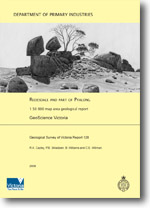GSV Report 128 - Redesdale and part of Pyalong 1:50 000 map area geological report
 |
| |||||||||||||||||||||||||||||
Product description:Download The downloadable version of this report is supplied in PDF format (8.6MB). Abstract The Redesdale and part of Pyalong geological map area (REDESDALE) is the northwestern part of the Woodend 1:100 000 map area. The report documents the structure, stratigraphy, geophysical character and mineral potential of the Cambrian and Ordovician sequences across REDESDALE. Several historic gold workings occur and their geological context is described. The report describes several physiographic units whose character is controlled primarily by rocktype—of particular interest are Permian glacial landscapes in the vicinity of Mia Mia and the spectacular Barfold Gorge, where the Campaspe River cuts through basalt. Much of bedrock across REDESDALE is Ordovician sandstone and slate of the eastern Bendigo Zone—a thick, deformed sequence of deep marine turbiditic sandstone and siltstone of the Ordovician Castlemaine Group. A short segment of the Heathcote Fault Zone also occurs in the map area, which exposes Cambrian oceanic meta-igneous rocks, shale and chert that underlie the Castlemaine Group. The map area extends a short distance into the Siluro-Devonian metasediments of the Melbourne Zone. The report and map showcases structural mapping of the Cambrian and Ordovician rocks of REDESDALE and includes a small number of new graptolite localities. These rocks were tightly folded in the Late Ordovician— Early Silurian to form a fold enveloping surface that dips gently southwest across much of the project area. The enveloping surface steepens to moderate west and southwest dips close to the Heathcote Fault Zone of the same age. The Mundy Gully goldfield lies close to this change in dip and may lie on splay faults from the Heathcote Fault Zone. The south plunge of folds in the north of REDESDALE appears to be due to the Early Devonian Tooborac Megakink. The Toorobac Megakink is similar in age to open folds developed in the adjacent Melbourne Zone. Known historic (19th century) gold workings in REDESDALE include the Mundy Gully reef gold deposits near Tooborac. Other reef gold deposits occur in granite and hornfels at Sugarloaf Hill southwest of Tooborac. To the west, small quantities of alluvial and reef gold occur near Redesdale. Further south are the ‘Italian Diggings’ alluvial gold workings. The Fosterville Fault was not found in the position previously interpreted. Instead a cluster of reverse faults with moderate west dips were found further west, near the Campaspe River. These faults are cryptic, mostly buried by Newer Volcanic basalt. Their mineralisation potential is unknown, but the largest of these faults – Pipers Creek Fault – may be a correlate of the Fosterville Fault. Well over half the map area is in Late Devonian granite of the Cobaw Batholith. This large composite body has intruded the folded sequence of the Bendigo and Melbourne Zones and has cut the Heathcote Fault Zone. Key project results are:
Bibliographic reference Cayley, R.A., Skladzien, P.B., Williams, B. & Willman, C.E., 2008. Redesdale and part of Pyalong 1:50 000 map area geological report. Geological Survey of Victoria Report 128. GeoScience Victoria, Department of Primary Industries. Related products:
| ||||||||||||||||||||||||||||||



